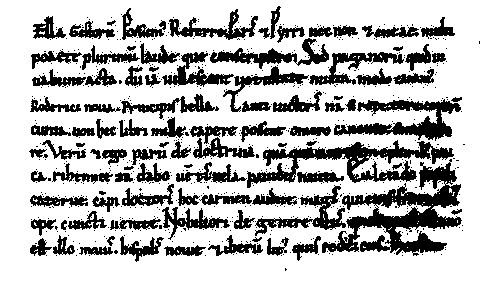Author(s) Date composed around 1083 | Language Latin Genre epic poetry | |
 | ||
Also known as Poema latino del Cid (Latin poem of the Cid) Manuscript(s) Unique manuscript. Bibliothèque nationale de France, ms. lat. 5132 | ||
The Carmen Campidoctoris ("Song of the Campeador") is an anonymous medieval Latin epic poem, consisting in 128 sapphic-adonic verses in 32 stanzas, with one line from an unfinished thirty-third. The earliest poem about the Spanish folk hero El Cid Campeador, it was found in the monastery of Santa Maria de Ripoll in the seventeenth century and was transferred to the Bibliothèque nationale de France, where it currently resides as manuscript lat. 5132.
Contents
Content
Subjectwise, the poem is a narrative of three of El Cid's victories: over an unknown Navarrese champion, over count García Ordóñez de Cabra, and finally over the Berenguer Ramon II, Count of Barcelona. The poem begins conventionally, with the poet confessing his unworthiness to sing of such a hero as El Cid, and moves quickly through his subject's youth, his early triumph over the champion from Navarre, and his loyal service to Sancho II of Castile and Alfonso VI of León. The anonymous poet blames the Cid's subsequent exile from court on certain enemies who turn the king against him. But the Cid is victorious over the army of García Ordóñez that Alfonso sent against him. The poet then describes, in great detail, a description of the Cid arming himself for battle against the Count of Barcelona, at Almenar near Lérida. The poem ends abruptly, obviously incomplete, before the battle.
The description of the Cid's weapons, the earliest in the literature, contains references to chainmail, a silver-plated helm with a golden gem on it, a lance, an anonymous sword with golden ornamentation (which may be Tizona, based on the description), and a shield depicting a "fierce shining golden dragon" (which is the only surviving description of the Cid's shield).
The Carmen also contains the earliest description of the Cid's ancestry, describing him as Nobiliori de genere ortus / Quod in Castello non est illo maius: "He sprung from a more noble family, there is none older than it in Castile." R. A. Fletcher suggests this is a discreet way of saying that the Cid's ancestors were not among the most noble, just nobler than some.
Date and authorship
The author of the Carmen was a good Latinist writing, to judge from his classical allusions, for a learned audience, probably at Ripoll. The hymn-like rhythm and rhyme strongly suggests that it was designed for public recitation. Scholars have dated the poem as early as 1083 (after the battle of Almenar in 1082) and as late as c.1100.
The motive of a Catalan monk in writing about a Castilian hero has been explained by the date of 1083 and the politics of Catalonia at that time. Since 1076 the brothers Berenguer Ramon II and Ramon Berenguer II had been trying to rule Catalonia jointly in accordance with their late father's wishes. This had proved unworkable and two divisions of the realm (1079 and 1080) had granted the Diocese of Vic, in which lay Ripoll, to Ramon Berenguer. The bishop of Vic, Berenguer Sunifred de Lluçà, was among Ramon's supporters. The Carmen was probably written by supporters of Ramon to celebrate his brother's defeat at the hands of the Cid, on the eve of civil war in Catalonia.
The Late Latin title campi doctor or campi doctus (literally "teacher of the [military] field"), rendered campeador in Castilian Romance, is first applied to the Cid by the anonymous author of the Carmen, and it may be his literary invention. The library of Ripoll may have contained references to the obscure fourth- and fifth-century Roman military usage. It is not known how the term, which originally indicated a "regimental drill-instructor", came to currency in eleventh-century Spain, with a meaning like "armiger".
